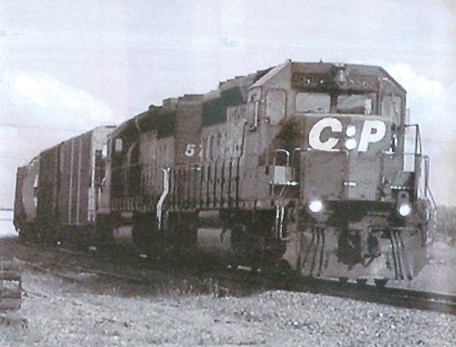Interview in 2004 with John Maluga, former conductor on C.P. Railway.
Photo: Ron Holmberg Fonds
The old mainline of the CPR is owned by Great Western Railway, but operated by the Canadian Pacific Railway. The freight trains in 2005 that pass through Yorkton, sometimes with 120 potash cars, are loaded at the Esterhazy potash mines and bound for the docks on the West coast. Usually they are solid potash freights, because CP Rail operates under contracts – the main purpose being to effect delivery of their goods as quickly as possible, and not be hindered by the stops that would be necessitated by a mixed cargo. Empty, a car weighs 30 tons; loaded with potash it is about 130 tons. Other times, you will see a solid train of 75 or more double stack containers on its way to Edmonton. These can contain all sorts of merchandise. Grain is hauled east; stacks of vehicles going west from the east, and foreign-made cars from the Orient are hauled east. Other cargoes contain lumber, propane gas, etc. A mixed train is called a “hot shot” freight, meaning it is riding high for its destination, with few planned stops.
Cars that bear foreign names such as the Santa Fe Railroad carry merchandise ordered from these places, loaded there and shipped to the consumers. You may see the same cars on the return trip, empty or sometimes loaded with Canadian merchandise bound for their original destination. You may also see the foreign railroad cars because CP Rail or the Canadian National have purchased smaller American companies and keep on using their cars as they were. Major railway companies have bought out smaller railways on both sides of the international boundary.
Freights going through from Melville are going north to the Port of Churchill. European ships come to the Port to pick up grain from the huge terminal there. Cars with propane gas go up to Churchill. This line connects with the Canadian National mainline at Melville. Yorkton people still wait for the train today — that is, to pass through the downtown as long lines of motorists watch a hundred or more cars go by. Many citizens, though, are annoyed at the wailing sound of a diesel engine’s horn as the numerous freights make their lonely passage through the city in the middle of the night. Assuredly, the romance of the train is all but gone. But, some of us still have the child’s awe for watching trains go by.
TO ALL READERS: The Yorkton Brick Mill Heritage Society is asking the readers to look into their souvenir boxes for photos of the flour mill history — the mill, grain delivery, mill elevator, trains on the Yorkton CP line, freight trains carrying booze cargo during Prohibition (Saskatchewan 1915-1924), fairs and band concerts, etc.
Contact Terri Lefebvre Prince,
Heritage Researcher,
City of Yorkton Archives,
Box 400, 37 Third Avenue North
Yorkton, Sask. S3N 2W3
306-786-1722
[email protected]




